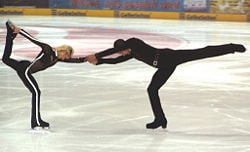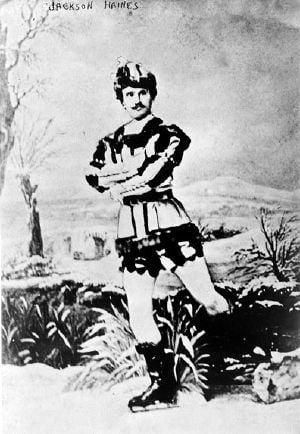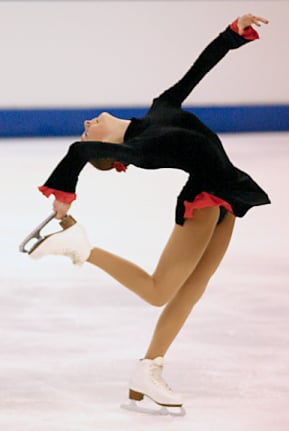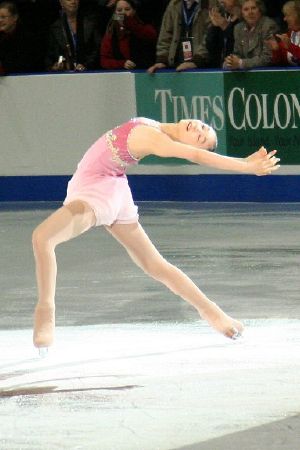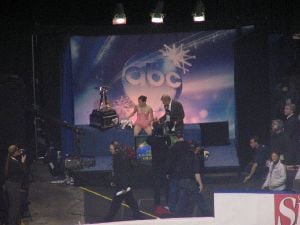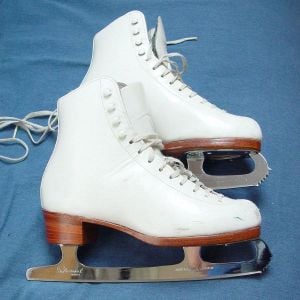Figure skating
Figure skating is a sport in which individuals, couples, or groups perform spins, jumps, and other moves on ice. Figure skaters compete at various levels from beginner up to the Olympic level (senior), and at local, national, and international competitions. The International Skating Union (ISU) regulates international figure skating judging and competitions.
Like dancing, figure skating combines grace and athleticism, requiring great discipline combined with skill. Skaters such as Sonja Henie and Peggy Fleming were among the most beloved athletes of their respective generations. Figure skating has grown into one of the highlights of the Winter Olympics, and is practiced worldwide.
Major international competitions are sanctioned by the ISU. These include the Winter Olympic Games, the World Championships, the World Junior Figure Skating Championships, the ISU Grand Prix of Figure Skating, the European Figure Skating Championships, and the Four Continents Figure Skating Championships.
History
Early times
While people have been ice skating for centuries, figure skating in its current form originated in the mid-nineteenth century.
In the late 1500's and early 1600's women were not allowed to skate in many countries. In Great Britain, figure skating gained popularity after Charles II returned from a trip to Holland. His trip combined with a terrible winter in Great Britain created the beginning of figure skating in 1662. British officers used ice skates during the time, and it also helped increase the sports popularity.
In 1742, a skating club was created in Scotland. At this time skates were designed with a longer blade and a round heel. During these innovations, skaters became more elegant on the ice, and started the practice of compulsory moves.
A Treatise on Skating (1772) by Englishman Robert Jones, is the first known account of figure skating. Competitions were then held in the "English style" of skating, which was formal and bears little resemblance to modern figure skating.
The first figure skating club in North America was introduced in 1849. The group met and skated on local river ice. As a safety requirement, they came prepared with rope in case another member fell into the water through thin ice.
American skater Jackson Haines, considered the "father of modern figure skating," introduced a new style of skating in the mid-1860s. This style, which incorporated free and expressive techniques, became known as the "international style." Although popular in Europe, Haines' style of skating was not widely adopted in the United States until long after his death.[1]
Early 1900s
The International Skating Union was founded in 1892. The first European Championship was held in 1891, and the first World Championship was held in 1896 and won by Gilbert Fuchs.
In 1902, a woman, Madge Syers, entered the World competition for the first time, finishing second. The ISU quickly banned women from competing against men, but established a separate competition for "ladies" in 1906. Pair skating was introduced at the 1908 World Championships, where the title was won by Anna Hübler & Heinrich Burger. The first Olympic figure skating competitions also took place in 1908.[2]
On March 20, 1914 an international figure skating championship was held in New Haven, Connecticut which was the ancestor of both the United States and Canadian National Championships. However, international competitions in figure skating were interrupted by World War I.
In the 1920s and 1930s, figure skating was dominated by Sonja Henie, who turned competitive success into a lucrative professional career as a movie star and touring skater. Henie also set the fashion for female skaters to wear short skirts and white boots.[3] The top male skaters of this period included Gillis Grafström and Karl Schäfer.
After World War II
Skating competitions were again interrupted for several years by World War II. After the war, with many European rinks in ruins, skaters from the United States and Canada began to dominate international competitions and to introduce technical innovations to the sport. Dick Button, 1948 and 1952 Olympic Champion, was the first skater to perform the double axel and triple loop jumps, as well as the flying camel spin.
The first World Championships in ice dancing were not held until 1952.[2] In its first years, ice dance was dominated by British skaters. The first World title holders were Jean Westwood and Lawrence Demmy.
The rise of the Soviet Union
On February 15, 1961, the entire U.S. figure skating team and their coaches were killed in the crash of Sabena Flight 548 in Brussels, Belgium en route to the World Championships in Prague. This tragedy sent the U.S. skating program into a period of rebuilding.
At the same time, the Soviet Union rose to become a dominant power in the sport, especially in the disciplines of pairs skating and ice dancing. At every Winter Olympics from 1964 until the present day, a Soviet or Russian pair has won gold, often considered the longest winning streak in modern sports history. (In 2002, Russians Yelena Berezhnaya and Anton Sikharulidze were forced to share gold with Canadians Jamie Salé and David Pelletier.)
The effect of television
Compulsory figures, in which the skater would trace a figure on the ice, formerly accounted for up to 60% of the score in singles figure skating, which meant that skaters who could build up a big lead in figures could win competitions even if they were mediocre free skaters. As television coverage of skating events became more important, so did free skating. Beginning in 1968, the ISU began to progressively reduce the weight of figures, and in 1973, the short program was introduced. With these changes, the emphasis in competitive figure skating shifted to increasing athleticism in the free skating. By the time figures were finally eliminated entirely from competition in 1990, Midori Ito had landed the first triple axel by a woman, and Kurt Browning the first quadruple jump by a man.
Television also played a role in removing the restrictive amateur status rules that once governed the sport. In order to retain skaters who might otherwise have given up their eligibility to participate in lucrative professional events, in 1995 the ISU introduced prize money at its major competitions, funded by revenues from selling the TV rights to those events.
Present day
Figure skating is a very popular part of the Winter Olympic Games, in which the elegance of both the competitors and their movements attract many spectators. Not surprisingly, the best skaters show many of the same physical and psychological attributes as gymnasts. Like ice hockey, figure skating is most popular in regions where cold winters produce natural ice. Dominant countries of the last 50 years have been Russia and the former Soviet Union, the United States, Canada, Germany and Japan. While many of the top U.S. and Russian skaters retired after the 2006 Winter Olympics, the sport is currently experiencing a surge in popularity in Asia, particularly in South Korea, China and Japan, as well as in the Nordic countries such as Norway and Finland.
Disciplines
Olympic sports in figure skating comprise the following disciplines:[4]
Individual skating
Singles competition for men and women (who are referred to as "ladies" in ISU rulebooks), in which skaters perform jumps, spins, step sequences, and other elements in their programs. In Individual competition, skaters are required to perform a short program, and a long program.
The short program consist of one third of the skaters total score and requires the competitor to go through the eight different required scoring categories that include different jumps and sequences. The short program lasts for 2 minutes and 40 seconds.
The long program lasts for 4 minutes and 30 seconds for men and 4 minutes for women and consists of the technical elements found in the short program and other elements as well. It is a "free skate," in which the skater creates their own routine to highlight their specific talents. It consists of two-thirds of the score.
Pairs skating
Couples in pairs skating consist of a woman and a man. Pairs perform side-by-side singles elements in unison as well as pair-specific elements such as throw jumps, in which the man 'throws' the woman into a jump; lifts, in which the woman is held above the man's head in one of various grips and positions; pair spins, in which both skaters spin together about a common axis; death spirals, and other elements. Judging for the pairs format is based on the difficulty, and timing of the team as well as the artistic elements added to the routine by the team.
Ice dancing
Ice dancing also consists of a woman and a man skating together. Ice dance differs from pairs in focusing on intricate footwork performed in close dance holds, in time with the music. Ice dance lifts must not go above the head, and one skate must be on the ice at all times. It was developed from the waltz and other types of ballroom dancing and was mostly popular at the start of the nineteenth century. In Ice dancing, teams must complete three different parts consisting of compulsory moves, the free dance, and the original dance. The compulsory moves or compulsories are when the two members must perform two dances that are selected by the judges and complete a total of 20 percent of the scorecard. The original dance is done when the skaters choreograph their own dance, deciding on the tempo, moves and rhythm. The original dance makes up 30 percent of the scoring and is scored mostly on the presentation of the team. The free dance consists of 50 percent of the score and is another type of dance involving the teams own choreographing and style
Other disciplines of figure skating include:
- Precision skating, for mixed-gender groups of 16 to 24 skaters. This discipline resembles a group form of ice dance with additional emphasis on precise formations of the group as a whole and complex transitions between formations. It was introduced as an official sport in 1994 by the ISU, but still has not gained recognition as an Olympic event.
- Moves in the field (known in the United Kingdom as field moves), which have replaced compulsory figures as a discipline to teach the same turns and edge skills in the context of fluid free skating movements instead of being constrained to artificially precise circles.
- Fours, a discipline that is to pairs as pairs is to singles. A fours team consists of two men and two women who perform singles and pairs elements in unison as well as unique elements that involve all four skaters.
- Adagio skating, a form of pair skating most commonly seen in ice shows, where the skaters perform many spectacular acrobatic lifts but few or none of the singles elements which competitive pairs must perform.
Jumps
Jumps involve the skater leaping into the air and rotating rapidly to land after completing one or more rotations. There are many types of jumps, identified by the way the skater takes off and lands, as well as by the number of rotations that are completed.
Most skaters rotate all their jumps in the counterclockwise direction. Some prefer to rotate clockwise, and a very small number of skaters can perform jumps in both directions. For clarity, all jumps will be described for the counterclockwise skater. Jumps are one of the most important parts of figure skating.
There are six major jumps in figure skating. All six are landed on one foot on the right back outside edge (with counterclockwise rotation, for single and multi-revolution jumps), but have different takeoffs, by which they may be distinguished. The two categories of jumps are toe jumps and edge jumps.
Toe jumps
Toe jumps are launched by tapping the toe pick of one skate into the ice, and include (in order of difficulty from easiest to hardest):
Toe loops take off from the back outside edge of the right foot and are launched by the left toe pick (toe walleys are similar, but take off from the back inside edge of the right foot); Flips, which take off from the back inside edge of the left foot and are launched by the right toe pick; Lutzes, which take off from the back outside edge of the left foot and are launched by the right toe pick.
Edge jumps
Edge jumps use no toe assist, and include:
Salchows, which take off from a left back inside edge. Allowing the edge to come round, the opposite leg helps launch the jump into the air and land on one foot; Loops (also known as Rittberger jumps) take off from a right back outside edge and land on the same edge; Axels, which are the only rotating jump to take off from a forward edge (the left outside edge). Because they take off from a forward edge, they include one-half extra rotations and are usually considered the hardest jump of the six. The similar jump with only half a rotation is called a waltz jump and is typically the first jump a skater learns.
Rotations and combinations
The number of rotations performed in the air for each jump determines whether the jump is a single, double, triple, or quad. Most elite male skaters perform triples and quads as their main jumps, while most elite female skaters perform all the triples except the Axel, which is usually double. Only six female skaters have ever been credited as successfully landing the triple Axel in competition, and only one has landed a quadruple jump (salchow) in competition.
In addition to jumps performed singly, jumps may also be performed in combination or in sequence. For a set of jumps to be considered a combination, each jump must take off from the landing edge of the previous jump, with no steps, turns, or change of edge in between jumps. This limits all jumps except the first to toe loops and loops (which take off from the right back outside edge on which the basic six jumps are landed). In order to use other jumps on the back end of a combination, connecting jumps such as a half loop (which is actually a full rotation, but lands on a left back inside edge) can be used, enabling the skater to put a salchow or flip at the end of the combination. In contrast, jump sequences are sets of jumps which may involve steps or changes of edge between the jumps.
Other jumps
There are also a number of other jumps which are usually performed only as single jumps and in elite skating are used as transitional movements or highlights in step sequences. These include the half loop, half flip, walley jump, split jump, waltz jump, inside Axel, and one-foot Axel.
Spins
There are many types of spins, identified by the position of the arms, legs, and angle of the back. Spins include the scratch spin, the sit spin, the camel spin, the layback spin, and a few flying spins. The skater rotates on the round part of the blade, called the ball of the foot, just behind the toe pick. Spins may be performed singly or in a sequence combining different types of spins.
Spins may be performed on either foot. Figure skaters are rarely able to spin in both directions; most favor one or the other. For skaters who rotate in a counterclockwise direction, a spin on the left foot is called a forward spin, while a spin on the right foot is called a back spin.
In pair skating and ice dancing, there are additionally pair spins and dance spins in which the two skaters rotate together around the same axis. Flying spins are spins that are initiated with a jump. These include the flying camel, flying sit spin, death drop, and butterfly spin. Usually, they go from a forward spin, to a back spin.
Spins are a required element in most figure skating competitions.
Lifts
Lifts are a required element in pair skating and ice dancing. Pairs lifts differ from dance lifts most notably in that dancers are not allowed to lift their partners above their shoulders.
Dance lifts are differentiated by the skating involved. There are seven kinds of lifts approved for ISU competitions. They are separated into short lifts and long lifts. There are many positions the lifting and the lifted partner can take to improve the difficulty of the lift. Each position must be held for at least three seconds to count and is permitted only once a program.
Unlike dance lifts, pair lifts are grouped by the holds involved. In ISU senior level competition, the man must rotate more than one times, but fewer than three a half. There are five different groups of pairs lifts, differentiated by the holds involved. Legal holds are Armpit holds, Waist holds, Hand to hip holds, and Hand to hand. There are two kinds of hand to hand lifts: press lifts and lasso lifts. The lasso lifts are considering the most difficult pair lifts.
Twist lifts are a form of a pair lifts where the lifted partner is thrown into the air, twists, and is caught by the lifted partner. The lady may do a split before the twist, called a split twist. This is not mandatory, but it increases the level of the element. The lady must be caught by her waist in the air. She lands on the backward outside edge. The man also ends the lift on one foot.
In both pairs and dance, lifts that go on longer than allowed receive deductions.
Steps and turns
Step sequences are a required element in competition programs. They involve a combination of turns, steps, hops and edge changes, performed in a straight line down the ice, in a circle, or in an S shape (serpentine step sequence).
The various turns which skaters can incorporate into step sequences include:
Three turns, so called because the blade turns into the curve of the edge or lobe to leave a tracing resembling the numeral "3." Bracket turns, in which the blade is turned counter to the curve of the lobe, making a tracing resembling a bracket ("}"), Rockers and counters, one-foot turns that involve a change of lobe as well as of direction, Mohawks, the two-foot equivalents of three turns and brackets. Choctaws, the two-foot equivalents of rockers and counters.
Spiral sequences are also required in ladies and pair skating, and involve lifting the free leg above the hip to a position equivalent of the arabesque in ballet, or the scale in gymnastics. Spirals can be performed while skating forwards or backwards, and are distinguished by the edge of the blade used and the foot they are skated on. Some spiral sequences also include Biellman spirals, side-spirals, and other positions.
Other free skating movements which can be incorporated into step sequences or used as connecting elements include lunges and spread eagles. An Ina Bauer is similar to a spread eagle performed with one knee bent and typically an arched back. Hydro blading refers to a deep edge performed with the body as low as possible to the ice in a near-horizontal position.
Competition format and scoring
The International Skating Union (ISU) is the governing body for international competitions in figure skating, including the World Championships and the figure skating events at the Winter Olympic Games.
In singles and pairs figure skating competition, competitors must perform two routines, the "short program," in which the skater must complete a list of required elements consisting of jumps, spins and steps; and the "free skate" or "long program," in which the skaters have slightly more choice of elements. Ice dancing competitions usually consist of three phases: one or more "compulsory dances"; an "original dance" to a ballroom rhythm that is designated annually; and a "free dance" to music of the skaters' own choice.
The ISU Judging System
In 2004, in response to the judging controversy during the 2002 Winter Olympics, the ISU adopted the International Judging System (IJS) which became mandatory at all international competitions in 2006, including the 2006 Winter Olympics. The new system is often informally referred to as the "Code of Points," however, the ISU has never used the term to describe their system in any of their official communications.
Under the new system, points are awarded individually for each skating element, and the sum of these points is the total element score (TES). Competitive programs are constrained to have a set number of elements. Each element is judged first by a technical specialist who identifies the specific element and determines its base value. The technical specialist uses instant replay video to verify things that distinguish different elements; e.g., the exact foot position at take-off and landing of a jump. The decision of the technical specialist determines the base value of the element. A panel of twelve judges then each award a mark for the quality and execution of the element. This mark is called the grade of execution (GOE) that is an integer from -3 to +3. The GOE mark is then translated into another value by using the table of values in ISU rule 322. The GOE value from the twelve judges is then processed with a computerized random selection of nine judges, then discarding the high and low value, and finally averaging the remaining seven. This average value is then added (or subtracted) from the base value to get the total value for the element.[5]
The program components score (PCS) awards points to holistic aspects of a program or other nuances that are not rewarded in the total element score. The components are:
- skating skills (SS),
- transitions (TR),
- performance/execution (PE),
- choreography (CH),
- interpretation (IN).
The only exception is the compulsory dance, which has no choreography or transition marks because the steps are preset. A detailed description of each component is given in ISU rule 322.2. Judges award each component a raw mark from 0 to 10 in increments of 0.25, with a mark of 5 being defined as "average." For each separate component, the raw marks are then selected, trimmed, and averaged in a manner akin to determining a grade of execution. The trimmed mean scores are then translated into a factored mark by multiplying by a factor that depends on the discipline, competition segment, and level. Then the five (or four) factored marks are added to give the final PCS score.
The total element score and the program components score are added to give the total score for a competition segment (TSS). A skater's final placement is determined by the total of their scores in all segments of a competition. No ordinal rankings are used to determine the final results.
Equipment
Figure skates
Figure skates differ from hockey skates most visibly in having a set of large, jagged teeth called toe picks (also called "toe rakes") on the front of the blade. The toe picks are used primarily in jumping, but not for stroking or spins. Blades are mounted to the sole and heel of the boot with screws. Typically, high-level figure skaters are professionally fitted for their boots and blades at a reputable skate shop in their area.
Ice dancers' blades are about an inch shorter in the rear than those used by skaters in other disciplines, to accommodate the intricate footwork and close partnering in dance.
Hard plastic skate guards are used when the skater must walk in his or her skates when not on the ice. The guard protects the blade from dirt or material on the ground that may dull the blade. Soft blade covers called soakers are used to absorb condensation and protect the blades from rust when the skates are not being worn.
Clothing
For practice skating, figure skaters of both sexes usually wear leggings, tight fitting, flexible pants. Tights are also worn with dresses, skirts, sometimes shorts and underneath leggings for extra warmth and aesthetic qualities. In competition, women may wear skirts or pants, though skirts are far more popular. Men always wear pants. The costumes are less revealing than they at first appear. Competition outfits for skaters of both sexes, especially in ice dance, are often theatrical and revealing, with flesh-colored fabric used to facilitate the illusion, in spite of repeated attempts to ban clothing that gives the impression of "excessive nudity" or that is otherwise inappropriate for athletic competition.[6] Many women also wear makeup and style their hair in neat buns or ponytails during competitions.
Notes
- ↑ U.S. Figure Skating History, accessed September 4, 2006.
- ↑ 2.0 2.1 Some Key Dates in ISU History. ISU [1] accessdate 2006-09-05
- ↑ Paul Hunt. 100 Greatest Female Athletes: Sonja Henie. CNN Sports Illustrated [2] accessdate 2006-09-05
- ↑ Figure skating at Olympic.org, accessed September 4, 2006.
- ↑ ISU Judging System for Figure Skating and Ice Dancing 2004/5, accessed September 4, 2006.
- ↑ "The 1999 Official USFSA Rulebook.," SSR 19.00. USFSA, 1998.
ReferencesISBN links support NWE through referral fees
- Boo, Michael. The Story of Figure Skating. HarperTrophy, 1998. ISBN 0688158218.
- Dĕdič, Josef. Single Figure Skating. Prague: Olympia, 1975. OCLC 2638092
- Evaluation of Errors in Figures, 6th ed. USFSA, 1964. OCLC 13707298
- Johnson, Susan A., "And Then There Were None." Skating 1991. ISSN 0037-6132
- Ogilvie, Robert S. Competitive Figure Skating:A Parent's Guide. HarperCollins, 1985. ISBN 006015375X.
- Petkevich, John Misha. Figure Skating: Championship Techniques. 1989. ISBN 0452262097.
- Rossano, George. Mechanics of Lifts. Retrieved July 22, 2022.
- Smith, Beverley. Figure Skating: A Celebration. McClelland & Stewart, 1995. ISBN 0771028199.
- Wright, Benjamin T. Skating in America (1921-1995). Colorado Springs, CO: United States Figure Skating Association, 1996. OCLC 36733842
- ISU Crystal Reports official skaters' bios. Retrieved July 22, 2022.
- Washington Post: All You Need to Know About Figure Skating Winter Olympics Nagano, 1998. Washington Post. Retrieved July 22, 2022.
- Figure skating firsts Retrieved July 22, 2022.
External links
All links retrieved March 26, 2024.
Credits
New World Encyclopedia writers and editors rewrote and completed the Wikipedia article in accordance with New World Encyclopedia standards. This article abides by terms of the Creative Commons CC-by-sa 3.0 License (CC-by-sa), which may be used and disseminated with proper attribution. Credit is due under the terms of this license that can reference both the New World Encyclopedia contributors and the selfless volunteer contributors of the Wikimedia Foundation. To cite this article click here for a list of acceptable citing formats.The history of earlier contributions by wikipedians is accessible to researchers here:
The history of this article since it was imported to New World Encyclopedia:
Note: Some restrictions may apply to use of individual images which are separately licensed.
